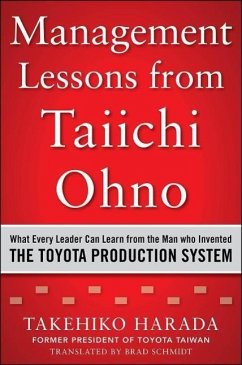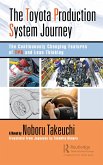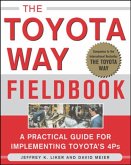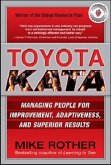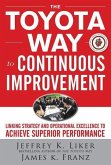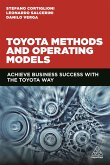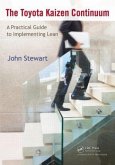Takehiko Harada
Management Lessons from Taiichi Ohno: What Every Leader Can Learn from the Man Who Invented the Toyota Production System
Takehiko Harada
Management Lessons from Taiichi Ohno: What Every Leader Can Learn from the Man Who Invented the Toyota Production System
- Gebundenes Buch
- Merkliste
- Auf die Merkliste
- Bewerten Bewerten
- Teilen
- Produkt teilen
- Produkterinnerung
- Produkterinnerung
Having spent 40 years working at the side of Taichii Ohno at Toyota, the author recounts his experiences transforming operations as we know them.
Andere Kunden interessierten sich auch für
![The Toyota Production System Journey The Toyota Production System Journey]() Noboru TakeuchiThe Toyota Production System Journey36,99 €
Noboru TakeuchiThe Toyota Production System Journey36,99 €![Toyota Production System Toyota Production System]() Yasuhiro Monden (Mejiro University)Toyota Production System105,99 €
Yasuhiro Monden (Mejiro University)Toyota Production System105,99 €![The Toyota Way Fieldbook The Toyota Way Fieldbook]() Jeffrey LikerThe Toyota Way Fieldbook33,99 €
Jeffrey LikerThe Toyota Way Fieldbook33,99 €![Toyota Kata: Managing People for Improvement, Adaptiveness and Superior Results Toyota Kata: Managing People for Improvement, Adaptiveness and Superior Results]() Mike RotherToyota Kata: Managing People for Improvement, Adaptiveness and Superior Results30,99 €
Mike RotherToyota Kata: Managing People for Improvement, Adaptiveness and Superior Results30,99 €![The Toyota Way to Continuous Improvement: Linking Strategy and Operational Excellence to Achieve Superior Performance The Toyota Way to Continuous Improvement: Linking Strategy and Operational Excellence to Achieve Superior Performance]() Jeffrey LikerThe Toyota Way to Continuous Improvement: Linking Strategy and Operational Excellence to Achieve Superior Performance44,99 €
Jeffrey LikerThe Toyota Way to Continuous Improvement: Linking Strategy and Operational Excellence to Achieve Superior Performance44,99 €![Toyota Methods and Operating Models Toyota Methods and Operating Models]() Stefano CortiglioniToyota Methods and Operating Models58,99 €
Stefano CortiglioniToyota Methods and Operating Models58,99 €![The Toyota Kaizen Continuum The Toyota Kaizen Continuum]() John Stewart (Monomoy Capital Partners, Midway, Kentucky, USA)The Toyota Kaizen Continuum36,99 €
John Stewart (Monomoy Capital Partners, Midway, Kentucky, USA)The Toyota Kaizen Continuum36,99 €-
-
-
Having spent 40 years working at the side of Taichii Ohno at Toyota, the author recounts his experiences transforming operations as we know them.
Hinweis: Dieser Artikel kann nur an eine deutsche Lieferadresse ausgeliefert werden.
Hinweis: Dieser Artikel kann nur an eine deutsche Lieferadresse ausgeliefert werden.
Produktdetails
- Produktdetails
- Verlag: McGraw-Hill Education - Europe
- Seitenzahl: 176
- Erscheinungstermin: 13. Juli 2015
- Englisch
- Abmessung: 237mm x 164mm x 27mm
- Gewicht: 400g
- ISBN-13: 9780071849739
- ISBN-10: 0071849734
- Artikelnr.: 41524186
- Herstellerkennzeichnung
- Libri GmbH
- Europaallee 1
- 36244 Bad Hersfeld
- gpsr@libri.de
- Verlag: McGraw-Hill Education - Europe
- Seitenzahl: 176
- Erscheinungstermin: 13. Juli 2015
- Englisch
- Abmessung: 237mm x 164mm x 27mm
- Gewicht: 400g
- ISBN-13: 9780071849739
- ISBN-10: 0071849734
- Artikelnr.: 41524186
- Herstellerkennzeichnung
- Libri GmbH
- Europaallee 1
- 36244 Bad Hersfeld
- gpsr@libri.de
Takehiko Harada joined Toyota Motor Corporation in 1968, where he served as machine department head, project general manger of the Operations Management Consulting Division (Toyota's TPS deployment group), and Head for engineering works.
Translator's Notes and Insights ix
Introduction 1
CHAPTER 1: Learning from Mr. Taiichi Ohno
Lesson 1: No One Really Understood What I Was Saying, So I Had to Go to the
Gemba and Give Detailed Instructions 7
Lesson 2: Kaizen Equals Getting Closer to the Final Process 11
Lesson 3: You Need by the Line Only the Parts for the Car You Are
Assembling Now 17
Lesson 4: Building in Batches Stunts the Growth of Your Operations (Don't
Combine Kanbans and Build a Group of Them) 20
Lesson 5: Nine Out of Ten, One Out of Ten 24
Lesson 6: The Foreman or Leader Is the One Who "Breaks" the Standard (When
You Make an Improvement and You Can Take Out One Person, Give Up Your Best
Person) 29
Lesson 7: Multiskilling Means Learning the Next Process-Keep It Flowing
Until You Reach the Last Process 32
Lesson 8: What's That Red Circle on the Top Right of That Graph? 35
Lesson 9: Are You as the Manager Having Them Do It, or Are They Just Doing
It Their Way? Which Is It, Man? 39
Lesson 10: Standard Work for the Andon Is, "Go There When It Flashes" 42
Lesson 11: Standard Work Is the Foundation of Kanban 45
Lesson 12: When the Worker Pushes the Start Button, He Has Stopped Moving.
Can't You Guys Figure Out a Way for Him to Push Start While Still Moving?
49
Lesson 13: You Bought an Expensive Machine, and Now You Want an Expensive
Foreman or Engineer to Run It? Are You Mad? 52
Lesson 14: Engineers in Production Become the Horizontal Threads in the
Cloth 55
Lesson 15: The Lowest Kanban Quantity Should Be Five 60
CHAPTER 2: The Role of the Top
The Management and Structure Needed to Have a Successful Toyota Production
System Deployment 65
The Role of Top Management: People Who Can Change the Structure (Rules,
Organization, and Operations) Based on Changes the Production Environment
Faces 70
The Foundation of Operations: How the Top Should Look at Things from Four
Perspectives 72
CHAPTER 3: The Role of Management: Enable Your Employees to Do the Work
Well
To All You Managers Out There 81
Managers Are There to Create an Environment in Which Increases in Flow
Happen 84
Giving Authority: Growing People You Can Empower 89
Management Should Make Workplaces That Motivate People to Work and Sustain
the Motivation 98
CHAPTER 4: If You Respect Other People, They Will Trust You
Talk to the Top People and Other Expatriates About Their Experience 120
Think of Managing an Overseas Plant as a Three-Story Building 121
Make an Environment Where It's OK to Say, "I'm Sorry" 127
Make the Toyota Production System a Pillar of the Management of the Entity
129
Be Proactive in Encouraging the Toyota Production System Inside and Outside
Your Company 132
Choose a Local Manager for Working with Suppliers 134
How to Deploy the Toyota Production System in Suppliers 137
Top Management Must Visit and Coach Suppliers at Least Three Times a Year
139
The Factory Must Be Run by Local Management, Starting with the Factory
Manager and All the Way Down 141
Make Japanese the Offi cial Company Language 143
Become an Executive Who People Can Trust. Respect Othersand They Will Trust
You 145
Afterword: To Those Top Managers Who Are Thinking of Applying the Toyota
Principles to Make a Wonderful Operation 151
Index 157
Introduction 1
CHAPTER 1: Learning from Mr. Taiichi Ohno
Lesson 1: No One Really Understood What I Was Saying, So I Had to Go to the
Gemba and Give Detailed Instructions 7
Lesson 2: Kaizen Equals Getting Closer to the Final Process 11
Lesson 3: You Need by the Line Only the Parts for the Car You Are
Assembling Now 17
Lesson 4: Building in Batches Stunts the Growth of Your Operations (Don't
Combine Kanbans and Build a Group of Them) 20
Lesson 5: Nine Out of Ten, One Out of Ten 24
Lesson 6: The Foreman or Leader Is the One Who "Breaks" the Standard (When
You Make an Improvement and You Can Take Out One Person, Give Up Your Best
Person) 29
Lesson 7: Multiskilling Means Learning the Next Process-Keep It Flowing
Until You Reach the Last Process 32
Lesson 8: What's That Red Circle on the Top Right of That Graph? 35
Lesson 9: Are You as the Manager Having Them Do It, or Are They Just Doing
It Their Way? Which Is It, Man? 39
Lesson 10: Standard Work for the Andon Is, "Go There When It Flashes" 42
Lesson 11: Standard Work Is the Foundation of Kanban 45
Lesson 12: When the Worker Pushes the Start Button, He Has Stopped Moving.
Can't You Guys Figure Out a Way for Him to Push Start While Still Moving?
49
Lesson 13: You Bought an Expensive Machine, and Now You Want an Expensive
Foreman or Engineer to Run It? Are You Mad? 52
Lesson 14: Engineers in Production Become the Horizontal Threads in the
Cloth 55
Lesson 15: The Lowest Kanban Quantity Should Be Five 60
CHAPTER 2: The Role of the Top
The Management and Structure Needed to Have a Successful Toyota Production
System Deployment 65
The Role of Top Management: People Who Can Change the Structure (Rules,
Organization, and Operations) Based on Changes the Production Environment
Faces 70
The Foundation of Operations: How the Top Should Look at Things from Four
Perspectives 72
CHAPTER 3: The Role of Management: Enable Your Employees to Do the Work
Well
To All You Managers Out There 81
Managers Are There to Create an Environment in Which Increases in Flow
Happen 84
Giving Authority: Growing People You Can Empower 89
Management Should Make Workplaces That Motivate People to Work and Sustain
the Motivation 98
CHAPTER 4: If You Respect Other People, They Will Trust You
Talk to the Top People and Other Expatriates About Their Experience 120
Think of Managing an Overseas Plant as a Three-Story Building 121
Make an Environment Where It's OK to Say, "I'm Sorry" 127
Make the Toyota Production System a Pillar of the Management of the Entity
129
Be Proactive in Encouraging the Toyota Production System Inside and Outside
Your Company 132
Choose a Local Manager for Working with Suppliers 134
How to Deploy the Toyota Production System in Suppliers 137
Top Management Must Visit and Coach Suppliers at Least Three Times a Year
139
The Factory Must Be Run by Local Management, Starting with the Factory
Manager and All the Way Down 141
Make Japanese the Offi cial Company Language 143
Become an Executive Who People Can Trust. Respect Othersand They Will Trust
You 145
Afterword: To Those Top Managers Who Are Thinking of Applying the Toyota
Principles to Make a Wonderful Operation 151
Index 157
Translator's Notes and Insights ix
Introduction 1
CHAPTER 1: Learning from Mr. Taiichi Ohno
Lesson 1: No One Really Understood What I Was Saying, So I Had to Go to the
Gemba and Give Detailed Instructions 7
Lesson 2: Kaizen Equals Getting Closer to the Final Process 11
Lesson 3: You Need by the Line Only the Parts for the Car You Are
Assembling Now 17
Lesson 4: Building in Batches Stunts the Growth of Your Operations (Don't
Combine Kanbans and Build a Group of Them) 20
Lesson 5: Nine Out of Ten, One Out of Ten 24
Lesson 6: The Foreman or Leader Is the One Who "Breaks" the Standard (When
You Make an Improvement and You Can Take Out One Person, Give Up Your Best
Person) 29
Lesson 7: Multiskilling Means Learning the Next Process-Keep It Flowing
Until You Reach the Last Process 32
Lesson 8: What's That Red Circle on the Top Right of That Graph? 35
Lesson 9: Are You as the Manager Having Them Do It, or Are They Just Doing
It Their Way? Which Is It, Man? 39
Lesson 10: Standard Work for the Andon Is, "Go There When It Flashes" 42
Lesson 11: Standard Work Is the Foundation of Kanban 45
Lesson 12: When the Worker Pushes the Start Button, He Has Stopped Moving.
Can't You Guys Figure Out a Way for Him to Push Start While Still Moving?
49
Lesson 13: You Bought an Expensive Machine, and Now You Want an Expensive
Foreman or Engineer to Run It? Are You Mad? 52
Lesson 14: Engineers in Production Become the Horizontal Threads in the
Cloth 55
Lesson 15: The Lowest Kanban Quantity Should Be Five 60
CHAPTER 2: The Role of the Top
The Management and Structure Needed to Have a Successful Toyota Production
System Deployment 65
The Role of Top Management: People Who Can Change the Structure (Rules,
Organization, and Operations) Based on Changes the Production Environment
Faces 70
The Foundation of Operations: How the Top Should Look at Things from Four
Perspectives 72
CHAPTER 3: The Role of Management: Enable Your Employees to Do the Work
Well
To All You Managers Out There 81
Managers Are There to Create an Environment in Which Increases in Flow
Happen 84
Giving Authority: Growing People You Can Empower 89
Management Should Make Workplaces That Motivate People to Work and Sustain
the Motivation 98
CHAPTER 4: If You Respect Other People, They Will Trust You
Talk to the Top People and Other Expatriates About Their Experience 120
Think of Managing an Overseas Plant as a Three-Story Building 121
Make an Environment Where It's OK to Say, "I'm Sorry" 127
Make the Toyota Production System a Pillar of the Management of the Entity
129
Be Proactive in Encouraging the Toyota Production System Inside and Outside
Your Company 132
Choose a Local Manager for Working with Suppliers 134
How to Deploy the Toyota Production System in Suppliers 137
Top Management Must Visit and Coach Suppliers at Least Three Times a Year
139
The Factory Must Be Run by Local Management, Starting with the Factory
Manager and All the Way Down 141
Make Japanese the Offi cial Company Language 143
Become an Executive Who People Can Trust. Respect Othersand They Will Trust
You 145
Afterword: To Those Top Managers Who Are Thinking of Applying the Toyota
Principles to Make a Wonderful Operation 151
Index 157
Introduction 1
CHAPTER 1: Learning from Mr. Taiichi Ohno
Lesson 1: No One Really Understood What I Was Saying, So I Had to Go to the
Gemba and Give Detailed Instructions 7
Lesson 2: Kaizen Equals Getting Closer to the Final Process 11
Lesson 3: You Need by the Line Only the Parts for the Car You Are
Assembling Now 17
Lesson 4: Building in Batches Stunts the Growth of Your Operations (Don't
Combine Kanbans and Build a Group of Them) 20
Lesson 5: Nine Out of Ten, One Out of Ten 24
Lesson 6: The Foreman or Leader Is the One Who "Breaks" the Standard (When
You Make an Improvement and You Can Take Out One Person, Give Up Your Best
Person) 29
Lesson 7: Multiskilling Means Learning the Next Process-Keep It Flowing
Until You Reach the Last Process 32
Lesson 8: What's That Red Circle on the Top Right of That Graph? 35
Lesson 9: Are You as the Manager Having Them Do It, or Are They Just Doing
It Their Way? Which Is It, Man? 39
Lesson 10: Standard Work for the Andon Is, "Go There When It Flashes" 42
Lesson 11: Standard Work Is the Foundation of Kanban 45
Lesson 12: When the Worker Pushes the Start Button, He Has Stopped Moving.
Can't You Guys Figure Out a Way for Him to Push Start While Still Moving?
49
Lesson 13: You Bought an Expensive Machine, and Now You Want an Expensive
Foreman or Engineer to Run It? Are You Mad? 52
Lesson 14: Engineers in Production Become the Horizontal Threads in the
Cloth 55
Lesson 15: The Lowest Kanban Quantity Should Be Five 60
CHAPTER 2: The Role of the Top
The Management and Structure Needed to Have a Successful Toyota Production
System Deployment 65
The Role of Top Management: People Who Can Change the Structure (Rules,
Organization, and Operations) Based on Changes the Production Environment
Faces 70
The Foundation of Operations: How the Top Should Look at Things from Four
Perspectives 72
CHAPTER 3: The Role of Management: Enable Your Employees to Do the Work
Well
To All You Managers Out There 81
Managers Are There to Create an Environment in Which Increases in Flow
Happen 84
Giving Authority: Growing People You Can Empower 89
Management Should Make Workplaces That Motivate People to Work and Sustain
the Motivation 98
CHAPTER 4: If You Respect Other People, They Will Trust You
Talk to the Top People and Other Expatriates About Their Experience 120
Think of Managing an Overseas Plant as a Three-Story Building 121
Make an Environment Where It's OK to Say, "I'm Sorry" 127
Make the Toyota Production System a Pillar of the Management of the Entity
129
Be Proactive in Encouraging the Toyota Production System Inside and Outside
Your Company 132
Choose a Local Manager for Working with Suppliers 134
How to Deploy the Toyota Production System in Suppliers 137
Top Management Must Visit and Coach Suppliers at Least Three Times a Year
139
The Factory Must Be Run by Local Management, Starting with the Factory
Manager and All the Way Down 141
Make Japanese the Offi cial Company Language 143
Become an Executive Who People Can Trust. Respect Othersand They Will Trust
You 145
Afterword: To Those Top Managers Who Are Thinking of Applying the Toyota
Principles to Make a Wonderful Operation 151
Index 157

